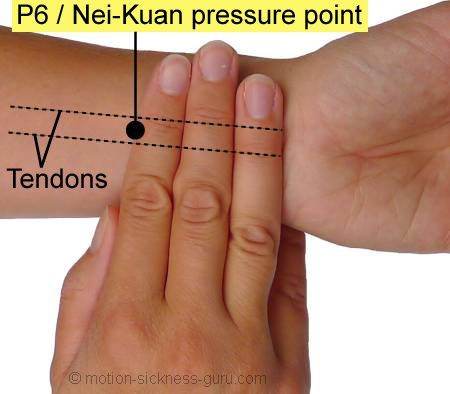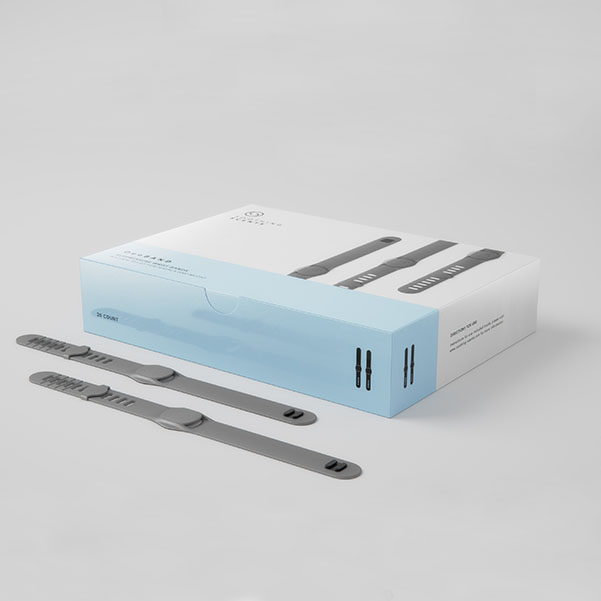To mark the launch of our new medical DuoBAND, founder Wendy Nichols explains how to use P6 acupressure bands, and how they can help medical professionals in the more traditional hospital setting.
For those of us from conventional healthcare backgrounds, understanding alternative therapies for nausea, like P6 acupressure bands, hasn’t come easy. In our world, a symptom appears, a drug is given, a receptor site is occupied…and voila! Relief ensues.
Unfortunately, unwanted side effects can also make an appearance, which is why many of us traditionalists are looking past the prescription pad towards more natural ways to manage our patients’ nausea.
Long before the hypodermic needle was even conceived, alternative treatment methods were well-established. In traditional Chinese medicine, one’s life force (‘chi’, or energy) is thought to be channeled through the body along ‘meridians’. Certain points along these meridians, when stimulated, produce healing effects in the body.
One such spot, the P6 acupressure point, is located at a three-finger breath below the wrist on the inner forearm, in between the two tendons, like so:

When pressure is applied to this spot, nausea and vomiting is relieved, most likely by vagal modulation that prolongs slow waves of gastric peristalsis and reduces anti-peristalsis.
*Many studies support this: P6 acupressure has been shown to produce clinically significant reductions in PONV, as well as nausea related to early pregnancy, labor, delivery, and chemotherapy. It not only relieves nausea, it helps prevent it too. (See up-to-date references below)
The easiest and most common way of providing stimulation to this point is through P6 acupressure bands, which are commercially available in a variety of materials. Usually provided in pairs, they are designed to be worn on each wrist, but often the presence of an IV limits the use to just one band in the healthcare setting, at least until the IV is discontinued. When shopping for P6 acupressure bands for your clinical department, you should look for the following features:
- Bands should be latex-free
- Available in both small and large sizes, with numerous adjustments
- Made of anti-microbial materials that resist bacterial colonization
- Easily cleanable if contaminated with blood, etc.
- Comfortable with prolonged use
At Soothing Scents, our new medical DuoBAND was designed specifically for the healthcare environment, and contain all of these features.
The DuoBAND can be used with our QueaseEASE ‘Clippy’ essential oil inhaler compact, combining the nausea prevention of P6 with the rescue relief of essential oils. This dual-action formula makes DuoBAND one powerful, all-natural nausea management system.
Since both P6 acupressure bands and therapeutic inhaled essential oils (TIEO) are designated nursing interventions, they require no physician’s order or control by the pharmacy. They can be stocked as a regular supply item near the bedside, readily accessible when needed.
How to Use P6 bands in the clinical setting:
- Identify the need. Patients with a history of motion sickness, PONV, and chemotherapy-related nausea, for example, can all benefit from P6 acupressure bands.
- Identify the P6 acupressure spot. Locate the P6 acupressure point by placing three fingers below the wrist and between the two tendons.
- Place the smooth plastic tab of the P6 band on this spot, and secure band to apply steady, gentle pressure.
- Apply a band to each wrist, unless an IV is present in the hand or wrist. After IV is discontinued, a second band may be applied.
- Bands may be sent home with patients for post-discharge nausea management
- Continually monitor band use for excessive tightness when patient is under anesthesia or sedated.
- Use with caution in patients receiving large amounts of IV fluid or at risk for fluid retention.
- Do not use on a fractured limb or a limb at risk of becoming edematous.
As our patients get seemingly older, sicker, and more medicated every day, it is reassuring to know that all-natural, evidence-based options exist when it comes to treating symptoms like nausea.
Do you use acupressure bands in your facility? Share your experience with us in the comment section below!
Until next time,
Wendy xo
*REFERENCE + ADDITIONAL READING
Mechanism of action of P6 acupressure
1. Sheng-Teng Huang, Gau-Yang Chen, Huey-Ming Lo, Jaung-Gang Lin, Yin-Shiung Lee, and Cheng-Deng Kuo. Increase in the Vagal Modulation by Acupuncture at Neiguan Point in the Healthy Subjects. The American Journal of Chinese Medicine 2005 33:01, 157-164
2. Shiotani, A., Tatewaki, M., Hoshino, E. and Takahashi, T. (2004), Effects of electroacupuncture on gastric myoelectrical activity in healthy humans. Neurogastroenterology & Motility, 16: 293–298.
3. Mehta P, et al., Contemporary acupressure therapy: Adroit cure for painless recovery of therapeutic ailments. Journal of Traditional and Complementary Medicine (2016)
https://www.researchgate.net/publication/305633990_Contemporary_acupressur
e_therapy_Adroit_cure_for_painless_recovery_of_therapeutic_ailments
Efficacy of P6 acupressure bands
4. Lee A, Chan SK, Fan LT. Stimulation of the wrist acupuncture point PC6 for preventing postoperative nausea and vomiting. The Cochrane database of systematic reviews. 2015;11:CD003281.
5. Matthews A, Haas DM, O’Mathúna DP, Dowswell T. Interventions for nausea and vomiting in early pregnancy. Cochrane Database Syst Rev. 2015 Sep 8;(9):CD007575.
6. Avc HS, Ovayolu N, Ovayolu Ö. Effect of Acupressure on Nausea-Vomiting in Patients With Acute Myeloblastic Leukemia. Holist Nurs Pract. 2016 Sep-Oct;30(5):257-62.
7. Genç F, Tan M. The effect of acupressure application on chemotherapy-induced nausea, vomiting, and anxiety in patients with breast cancer. Palliat Support Care. 2015 Apr;13(2):275-84. Epub 2014 Apr 30.
8. Nilsson I, Karlsson A, Lindgren L, Bergenheim T, Koskinen LO, Nilsson U. The efficacy of P6 acupressure with sea-band in reducing postoperative nausea and vomiting in patients undergoing craniotomy: a randomized, double-blinded, placebo-controlled study. J Neurosurg Anesthesiol. 2015 Jan;27(1):42-50.
NB: Unilateral wrist band
9. Molassiotis A, Russell W, Hughes J, Breckons M, Lloyd-Williams M, Richardson J, Hulme C, Brearley SG, Campbell M, Garrow A, Ryder WD. The effectiveness of acupressure for the control and management of chemotherapy-related acute and delayed nausea: a randomized controlled trial. J Pain Symptom Manage. 2014
Jan;47(1):12-25. Epub 2013 Apr 17.
https://www.deepdyve.com/lp/elsevier/the-effectiveness-of-acupressure-for-thecontrol-
10. Direkvand-Moghadam A, Khosravi A. Effect of Acupressure on Post–Operative Nausea and Vomiting in Cesarean Section: A Randomised Controlled Trial. Journal of Clinical and Diagnostic Research : JCDR. 2013;7(10):2247-2249.
11. Molassiotis A, Russell W, Hughes J, Breckons M, Lloyd-Williams M, Richardson J, Hulme C, Brearley S, Campbell M, Garrow A, Ryder D. The effectiveness and cost-effectiveness of acupressure for the control and management of chemotherapy-related acute and delayed nausea: Assessment of Nausea in Chemotherapy Research (ANCHoR), a randomised controlled trial Health Technology Assessment Volume:
17, Issue:26, Published in July 2013
https://dx.doi.org/10.3310/hta17260
12. Adib-Hajbaghery M, Etri M, Hosseainian M, Mousavi M-S. Pressure to the P6 Acupoint and Post-Appendectomy Pain, Nausea, and Vomiting: A Randomized Clinical Trial. Journal of Caring Sciences. 2013;2(2):115-122.
13. White PF, Zhao M, Tang J, Wender RH, Yumul R, Sloninsky AV, Naruse R, Kariger R,Cunneen S. Use of a disposable acupressure device as part of a multimodal antiemetic strategy for reducing postoperative nausea and vomiting. Anesth Analg.
2012 Jul;115(1):31-7.
Comment: Beam, WB, Weingarten, TN Sprung, J. Median neuropathy associated with acupoint stimulation strip. Anesth Analg. 2013; 117(1) 279.
14. Majholm B, Møller AM. Acupressure at acupoint P6 for prevention of postoperative nausea and vomiting: a randomised clinical trial. Eur J Anaesthesiol. 2011 Jun;28(6):412-9.
15. Cheong KB, Zhang J, Huang Y, Zhang Z. The Effectiveness of Acupuncture in Prevention and Treatment of Postoperative Nausea and Vomiting – A Systematic Review and Meta-Analysis. Baradaran HR, ed. PLoS ONE. 2013;8(12):e82474.
16. Sinha A, Paech MJ, Thew ME, Rhodes M, Luscombe K, Nathan E. A randomised, double-blinded, placebo-controlled study of acupressure wristbands for the prevention of nausea and vomiting during labour and delivery. Int J Obstet Anesth.
2011 Apr;20(2):110-7.
17. Shin, Hye Sook, Young A Song, and Sunhee Seo. “Effect of Nei–Guan point (P6) acupressure on ketonuria levels, nausea and vomiting in women with hyperemesis
gravidarum.” Journal of Advanced Nursing 59.5 (2007).
NB: Good background on Neiguan (P6) pressure point from TCM perspective
18. Wang G, Tian Y, Jia S, Zhou W, Zhang W. Pilot Study of Acupuncture Point Laterality: Evidence from Heart Rate Variability. Evidence-based Complementary and Alternative Medicine : eCAM. 2013:476064.
NB: Interesting study on laterality of P6 effect on heart rate; some P6 wristband
nausea trials use only one wrist.

